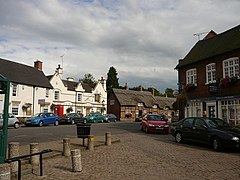Powerflush nearby to Market Bosworth

 Market Bosworth is a market town and civil parish in the English county of Leicestershire. It had a population of 1,906 at the time of the 2001 census, which increased to 2,097 at the time of the 2011 census. It is most famous for being close to the location of the decisive final battle of the Wars of the Roses.
Market Bosworth is a market town and civil parish in the English county of Leicestershire. It had a population of 1,906 at the time of the 2001 census, which increased to 2,097 at the time of the 2011 census. It is most famous for being close to the location of the decisive final battle of the Wars of the Roses.
Hinckley and Bosworth Rural District was formed in 1974 when Market Bosworth Rural District merged with Hinckley Rural District to form the district of Hinckley and Bosworth.
Despite its location in Leicestershire, the town’s postal address is Nuneaton, Warwickshire, with the postal area code CV13.
View this for cleaning out limescale in heating systems in these postcode areas:
- CV13
HISTORY
The historic cattle market in town closed in 1996. Building work here and elsewhere has revealed evidence of a Bronze Age settlement on the hill. On the east side of Barton Road, the remains of a Roman villa have been discovered. Bosworth was established as an Anglo-Saxon village in the eighth century.
Prior to the Norman Conquest of 1066, Bosworth had two manors, one of which belonged to an Anglo-Saxon knight named Fernot and some sokemen. Following the Norman conquest, both the Anglo-Saxon manors and the village were included in the lands awarded by William the Conqueror to the Count of Meulan from Normandy, Robert de Beaumont, 1st Earl of Leicester, as recorded in the Domesday Book of 1086. Following that, the village was passed down through marriage dowry to the English branch of the French House of Harcourt.
Sir William Harcourt was granted a royal charter by King Edward I to hold a market every Wednesday. Market Bosworth was given the name Market Bosworth on May 12, 1285, and it became a “town” by common definition on that day. St. Peter’s Church and the Red Lion pub, Bosworth’s two oldest structures, were built in the 14th century.
The Battle of Bosworth took place to the south of the town in 1485 as the final significant battle in the Wars of the Roses between the Houses of Lancaster and York, which resulted in King Richard III’s death. Following the discovery of Richard III’s remains in Leicester in 2012, the king’s funeral cortège passed through the town on its way to Leicester Cathedral for his reburial on Sunday 22 March 2015. This event is now commemorated with a floor plaque in front of the town square’s war memorial.
The manor passed from the Harcourts to the Greys in 1509.
Following Lady Jane Grey’s beheading in 1554, the manor of Bosworth was among the lands confiscated in the name of Mary I of England and her husband Philip II of Spain. They gave the manor to Edward Hastings, a Catholic nobleman. In 1567, his heirs sold it to Lord Mayor of London Sir Wolstan Dixie, who never lived in Bosworth. Sir Wolstan Dixie of Appleby Magna, his grand-nephew, was the first Dixie to settle in Bosworth in 1608. He began work on a manor house and park, as well as the establishment of the free Dixie Grammar School. Sir Beaumont Dixie, 2nd Baronet (1629–1692) designed the modern hall, Bosworth Hall.
In order to pay his gambling debts, the 11th Baronet ‘Beau’ Dixie was forced to auction off Bosworth Hall in 1885. Lady Agnes Tollemache purchased it, and her husband, Charles Tollemache Scott, expanded the estate, planted woodlands, and rebuilt the lodges and farms. In 1913, Lady Agnes’ daughter sold the estate.
The War Memorial in the town square honours 19 local men who died in World War I and 11 men who died in World War II.

